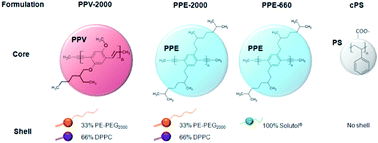Interactions of stealth conjugated polymer nanoparticles with human whole blood†
Abstract
Photoluminescent conjugated polymeric nanoparticles (CPNs) exhibit favourable properties as fluorescent probes due to their brightness, high photostability, tunable emission spectra and ease of surface modification. Potential cellular and clinical applications of these new diagnostic agents are easily envisioned, providing a rationale to study CPN biocompatibility. Here, stealth formulations of poly phenylene vinylene (PPV) and poly phenylene ethinylene (PPE) were manufactured and their interactions with human blood components assessed. CPNs were colloidally stable in isotonic fluids, but showed photoluminescence quenching in whole blood and plasma at levels as low as 10% supplementation. At concentrations >150 μg mL−1, stealth CPNs caused ∼10% erythrocyte haemolysis, which was likely due to unbound pegylated surfactant present in the formulation. Incubation of CPNs with both whole blood and isolated platelets showed no platelet activation, increases in platelet–monocyte aggregates or induction of platelet aggregation. Interestingly, PPE-CPN formulations inhibited adenosine diphosphate (ADP)-induced platelet aggregation in a dose-dependent manner, while PPV-CPNs did not show this effect. In conclusion, stealth CPN formulations exhibiting neutrally charged, pegylated surfaces do not stimulate platelet activation or aggregation, but may induce a low degree of haemolysis in the presence of free surfactant and can inhibit physiological mediators of platelet aggregation, such as ADP.

- This article is part of the themed collection: Highlighting materials research in the UK for biology and medicine

 Please wait while we load your content...
Please wait while we load your content...